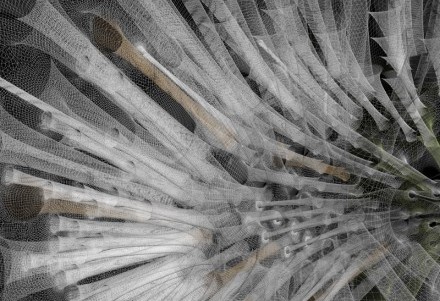
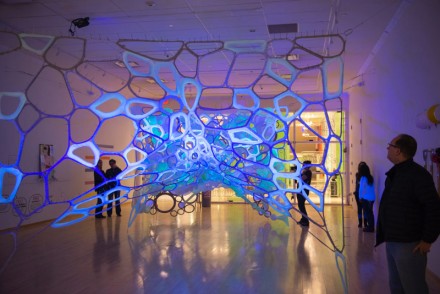
FALL 2014 Arriscraft Lecture Series
Jenny Sabin
Jenny Sabin Studio, Philadelphia
Elasticity and Networks: Computing BioMatters
Tonight, October 2nd at 7pm in the Main Lecture Hall, we will have the third lecture in this fall’s Arriscraft Series and features the experimental work of Jenny Sabin who operates an experimental architecture, design and art studio in Philadelphia. Can buildings behave more like organisms in their built environments? This talk will present ongoing trans-disciplinary research and applied projects spanning across the fields of cell biology, materials science, physics, electrical and systems engineering, and architecture.
The studio investigates the intersection of architecture and science through investigation into theories of biology, mathematics, practical exploration through fabrication and projection and collaboration across diverse disciplines. The work of Jenny Sabin Studio extends from conceptual provocations to materialized installations to innumerable publications, each pushing the boundaries of digital technology, fabrication, advanced geometry and material practices.
In addition to her professional explorations, Sabin is an Assistant Professor in the area of Design and Emerging Technologies in Architecture at Cornell University. In past she has taught design studios and electives in Architecture at the University of Pennsylvania as well as at the Institute for Medicine and Engineering.
Everyone is encouraged to attend. This event is free and open to the public.
In addition to the lecture Philip Beesley would like to warmly welcome everyone to join for Jenny Sabin’s workshop at 2:30-5pm on Thursday, Oct. 2 in the Founder’s Lounge, and then again 9:30 am-5 pm on Friday Oct. 3.
Thursday will include an orienting talk and launch. No special experience required, but those with Rhino and scripting ability will have the opportunity to mentor others and pursue specialized approaches with Jenny.
Matrix Architecture: Modeling Biological Reciprocity – A Landscape Takes Shape w/ Jenny E. Sabin
Workshop: October 2 – 3, 2014; The School of Architecture @ Waterloo
Outline courtesy of Philip Beesley. Images from Jenny Sabin Studio.
Rationale
Collaborations between architects and scientists offer up venues for productive exchange in design while revealing novel dynamic models for engaging-through simulation and visualization-the complex interactions between form and context. The material world that this type of exchange interrogates reveals examples of nonlinear fabrication and self-assembly at the surface, and at a deeper structural level. In parallel, this work offers up novel possibilities that question and redefine architecture within the greater scope of generative and ecological design and fabrication. This workshop situates itself at the forefront of a new direction for 21st-century architectural research practice-one that investigates the intersections of architecture and science, and applies insights and theories from biology and computation to the design of material structures. We will explore a deep organicity of interrelated parts, material components and building ecology. Generative design techniques will emerge with references to natural systems, not only as mimicry but also as trans-disciplinary translation of flexibility, adaptation, growth and complexity into realms of architectural manifestation. In particular, this workshop will touch upon long-standing traditions of shared relationships between architecture and biology, with sub-topics that include sustainability, ecological design, biomimcry, digital fabrication, experimental structures, and materials science.
Architects and structural engineers have historically looked to nature for design inspiration and models for producing and managing complexity in the built environment. Cable nets have been inspired by the high strength-to-weight ratio of the spider web; pneumatic structures after soap bubbles; vaults after shells and eggs composed of hard and curved materials; and geodesics after radiolarian. The structural designer, Robert Le Ricolais, studied the tension networks inherent to radiolarian in order to understand the dynamic properties and qualities of closed and open “skeletal” structures. Le Ricolais professed that he had “.found no better discipline in this unpredictable problem of form than to observe the prodigies created by nature.” (Le Ricolais 1973). Contemporary biology teaches the architect that context and dynamics count, leading to new models for building systems, structure, form and matter. This workshop will investigate biologically informed design through digital and analog simulation for the production of experimental material systems. Our model is the extracellular matrix.
Workshop Aims & Objectives
This workshop will be organized as a seminar/lecture and hands-on lab to explore the integration of complex biological phenomena towards the design, simulation, production, and digital fabrication of Bio-Inspired materials in the design arts and architecture. The intent of this workshop is to foster and expand the emerging dialogue between architecture and science, to gain new insights into how dynamic living systems might operate, to develop techniques for digital modeling, and to create experimental material systems through a new mode of design thinking. Drawing upon the NSF funded eSkin project (Yang, Sabin, Ihida-Stansbury, Engheta, Van der Spiegel, Lucia), we will actively engage rigorous scientific research as a point of departure. The insights as to how cells can modify their immediate microenvironment with minimal energy and maximal effect will inspire the biomimetic design of experimental and materialized sites. This workshop aims to deepen knowledge of biological complexity from a radically different viewpoint, and to
develop design thinking and tooling through the study of complex systems of matter, alongside introduction to advanced scripting logics in parametric and associative software and the production of hybrid material systems.
Workshop Deliverables: Elasticity and Networks
Bio-Inspired Materials and Design
Students will work in groups. The project will explore materiality at multiple length scales based upon understanding of non-linear, dynamic human cell behaviors on geometrically defined substrates. Central to this is the analysis and modeling of contextually and materially specified changes in geometry, pattern and effect at multiple length scales. Patterning options are highly flexible, ranging from geometric meshes, gradients, aperiodic and periodic patterns. The workshop will consist of three interconnected paths:
1. COMPONENT FAMILY – Evening of October 2nd: Based upon the provided template(s), which will serve as an underlying organization–an analog to the ECM-and your existing material assemblies, develop a family of components that respond and adapt to these informed landscapes. Give diagrammatic representations of the systems’ operation(s). Produce several physical iterations of the diagrammed swatches.
2. VISUALIZATION AND MODELING – Morning of October 3rd:
Generate digital design tools, whereby component based-mediated changes in pattern, geometry, material and environment are simulated in 3D digital environments via custom-written architectural algorithms. Several examples will be provided. Generate, test, interrogate and extend the relationships and variables that make up your code and describe the chosen topic. Give diagrammatic representations of the systems’ operation(s). Explore iteration digitally through your family of components.
3. EXPERIMENTAL MATERIAL SYSTEMS & SIMULATION – Afternoon and Evening of October 3rd: Using the provided templates and component family produced in part one as a guiding organization, apply the abstracted understanding of nonlinear and dynamic cell behaviors to the experimental design of materials and geometries at the human scale with maximum response to environment. Groups are encouraged to hybridize and interact through multiple seeded sites.
Required Software
Rhino 5 http://www.rhino3d.com/
This is the latest version of Rhino, which includes the RhinoPython scripting environment needed for the workshop.
Grasshopper: http://www.rhino3d.com/
Python plug-in for Grasshopper: http://www.food4rhino.com/
Software Resources
RhinoPython: http://python.rhino3d.com/
Python: http://learnpythonthehardway.
For more information:http://proquest.
Beazley, D. Python essential reference (4th ed.) New York: Addison-Wesley
Professional, 2009.
Summerfield, M. Programming in Python 3: a complete introduction to the
Python language (2nd ed.) New York: Addison-Wesley, 2010.
Philip Beesley Architect Inc.
pbeesley-pbai@rogers.com


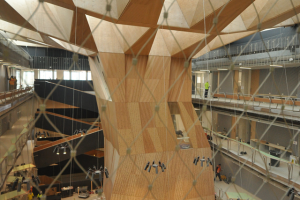
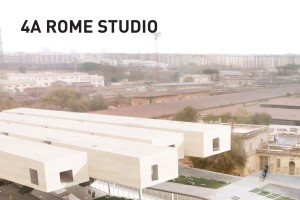
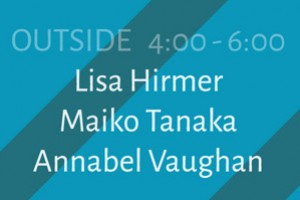
Leave a Reply